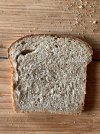- Joined
- Feb 28, 2022
- Messages
- 6
- Reaction score
- 2
been making yeast breads for several years. Taste, crumb etc fine . I machine knead, rise, punch down, fold to shape and use a lightly oiled bread tin. My problem is that I often find that when the dough is shaped the "folds" don't meld and persist into the cooked bread. Awkward for slicing and making sandwiches. Not sure what is wrong. I have tried wetter dough, using a firmer dough, increasing the oil and decreasing the oil. Tried warm rising and cool rising, Still happening. Any tips or thoughts? Picture is from a loaf that was 15% strong wholemeal and 85% strong white.
Thanks for looking
Thanks for looking

